DISCLAIMER: This article is intended to be a brief overview of the viability of dog food as a worst-case emergency food source, and not a comprehensive guide to food safety or nutrition. Weigh the risks carefully before eating any food not intended for human consumption, and only do so when there is no safer alternative.
At the beginning of the COVID pandemic in April 2020, Regina Loicano lived in abject fear, holed up in her Upper East Side, New York, walkup. She was so afraid of getting sick that she didn’t dare leave her small apartment. She was convinced that deadly germs were everywhere. Three weeks later, what was left of her food was gone and she resorted to eating pet food. Soon, the thought of starvation outweighed her fears of COVID and she tried to make it to the store, but she was so weak, she had to return back to her home. “I’ve been eating cat food and cat chow,” she told her rescuers, “and not been able to leave the house.”
For most, the thought of consuming dog food voluntarily would cause a shudder of disgust, and although our pets are cute, charming, playful, and more a part of the family unit than some actual humans, dogs can be kind of gross. They’re often excited to snack on meat that would repulse us, and the food we slop out of a can into their bowls has a powerful smell of pungent offal meats that are especially appetizing to the dogs. But in a dire emergency, can people eat dog food and survive? Or, like drinking water from a questionable source, does it run the risk of worsening our condition?
Why Would Anyone Eat Dog Food?
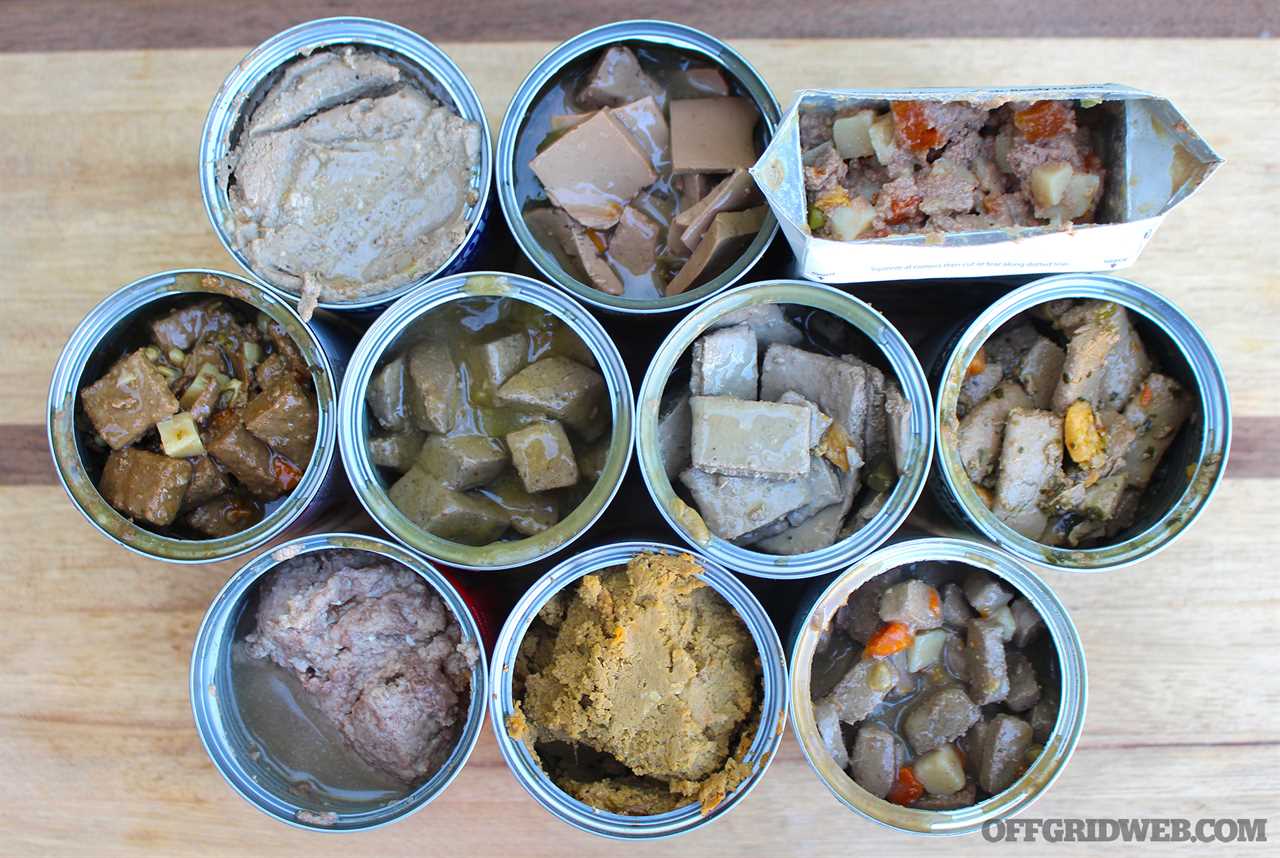
Above: At the back of the pantry, after all the “edible” cans of food have been consumed, your emergency situation has left you with nothing but cans of dog food. Are they edible? Are they healthy? Do they taste good? You can find out or you can starve to death.
The last of your food is gone. You ate what you could before it rotted, and the cans of soup and packages of pasta were the last human food left in the house. In the back of the pantry sits a few cans of dog food, and desperation is a remarkable motivator. Starvation is a particularly uncomfortable way to die, and logically, if your dog can eat it, why can’t a person?
Dog food is generally considered repugnant. Since dogs have more sensory receptors in their noses than they do taste buds on their tongues, smell is much more important to them than is taste, so dog food is designed to smell similar to rotting meat and dead animals, things canines over the millennia have craved. To voluntarily consume a can of dog food, one’s situation must be especially dire, an occurrence not uncommon in recent history. Dry dog food has some additional concerns, which we’ll discuss later.
Stories of people resorting to eating pet food have been underreported during nearly every natural disaster and economic depression since canned pet food was available. In the December 16, 1975, edition of the New York Times, columnist, human rights activist, and Professor Edward H. Peeples, Jr., chronicled his personal experiences of eating pet food in the 1950s poverty-stricken South. “At that time, it was not uncommon or startling to me to see dog food patties sizzling in a pan on the top of a stove or kerosene space heater in a dilapidated house with no running water, no refrigerator, no heat, no toilet, and the unrelenting stench of decaying insects. I simply thought of it as the unfortunate but unavoidable consequence of being poor in the South.”
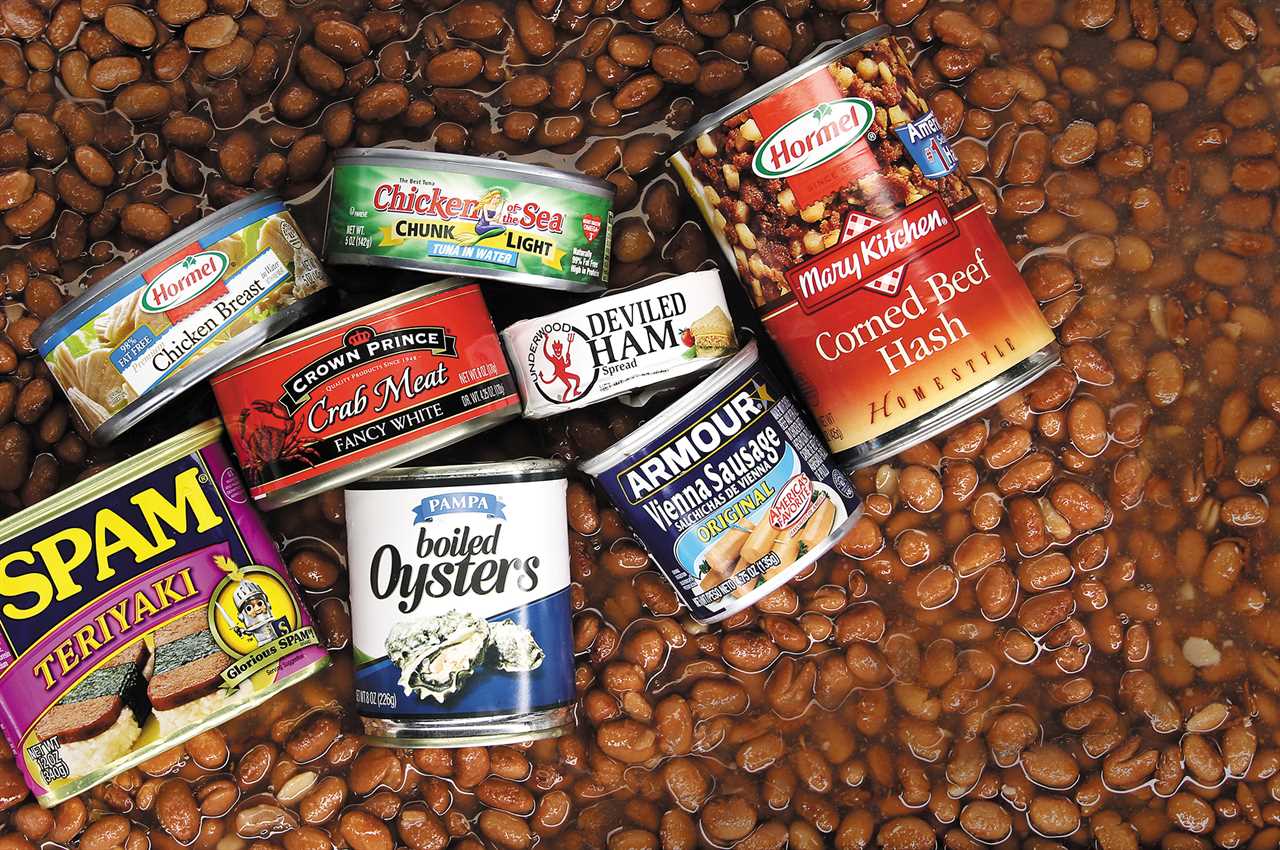
Above: As discussed in our Canned Meat Buyer's Guide, plenty of human food from a can isn't much more appealing than dog food.
“Except for the humiliation I experienced, eating canned pet food did not at the time seem to be particularly unpleasant. The dog food tasted pretty much like mealy hamburger, while the cat food was similar to canned fish that I was able to improve with mayonnaise, mustard, or catsup.”
In times of emergency, economic uncertainty, and extreme food shortages, pet food has been a viable option for literally millions of people around the globe. If it is there, consider eating it. It might save your life; but if you’re standing in the store with a can of dog food in one hand and a can of beef stew in the other, the choice is obvious — buy the stew. It’s made for a human and will taste and smell a great deal better than the food a dog would appreciate.
Most Canned Dog Food Is Safe
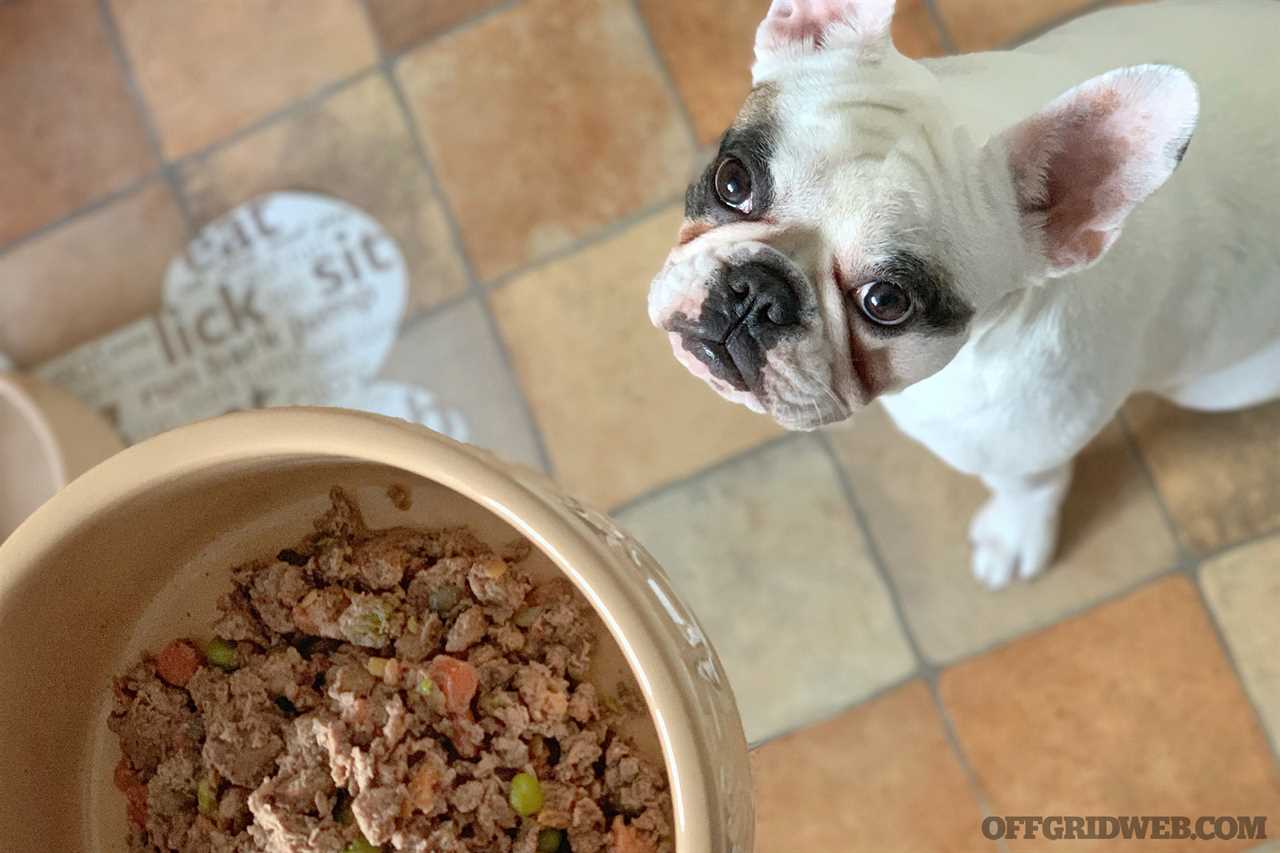
Although dog food isn’t intended for humans and the production of a can of dog food it isn’t up to the same standards as a can of soup, eating dog food to solve a short-term nutritional deficiency is unlikely to cause you any major harm. As long as the dog food is cooked and stored properly, there’s very little threat of foodborne illnesses such as salmonella, listeria, and E. coli. The cans are pasteurized, the contents cooked, and the ingredients are strictly controlled by not only government agencies (FDA and USDA), but by consumer watchdogs and animal advocate groups. Most times, people will care more about pets’ wellbeing than that of their fellow humans.
And if illness is still a concern once you’ve opened the can, merely cook it again. At a temperature of 167 degrees F, salmonella is killed, for example. For this reason, it isn’t recommended for humans to eat dry kibble at all, unless it was sourced and stored in a similar way as canned food. Dry dog food is more susceptible to rot as it is exposed to air and contaminants as soon as the bag is opened (proteins break down easily in moist air), and it would take you several days to consume even a small bag of kibble.
Public Health expert Susan L. Busse, BS, RDN, adds: “While dog food is not especially appealing to humans or designed to meet all their nutritional needs, it is generally not considered unsafe for humans to consume for a short time in survival situations. Dog food typically consists of some type of animal protein and grains. The ingredients are seldom as high quality as humans would typically eat, and while it is fortified with vitamins and minerals that dogs need, it’s not likely to meet all the nutritional needs of humans.”
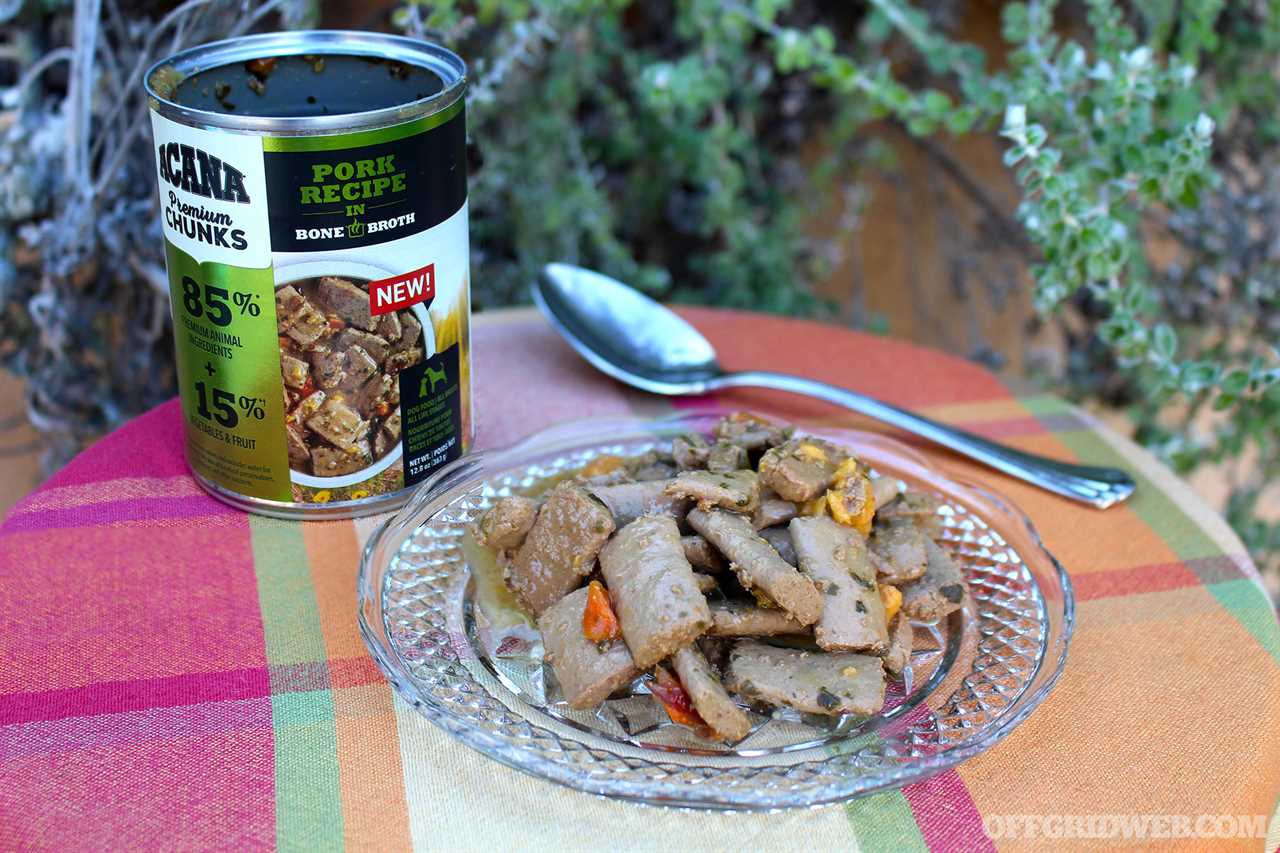
Above: Acana’s Premium Chunks Pork Recipe in Bone and Broth is a new line for the dog food manufacturer. Of the 10 cans, this is tops in appetizing appearance and overall flavor.
But this is where the perception of dog food as being disgusting random animal parts swept up off the floor and crammed into a can loses steam. Although dog food contains all kinds of animal parts that humans wouldn’t order at a restaurant, the fact is, smaller dog food manufacturers are using better cuts of meat, less chemicals, and more natural foods in their ingredients that, combined with cleaner and safer production methods, create a healthier meal for dogs … and for you if you need it.
Case in point: Mitch Felderhoff is the CEO of Muenster Milling Company in Muenster, Texas, a dog food company that makes all-natural dog food for well-heeled customers. Two years ago, for some publicity no doubt, Felderhoff decided to eat his own product — and nothing else — for 30 days. “It’s not that it’s a super healthy diet for people,” Felderhoff shared. “We’re doing it because we want you to know that we’re not going to feed your dog something unless we’ve eaten it first.”
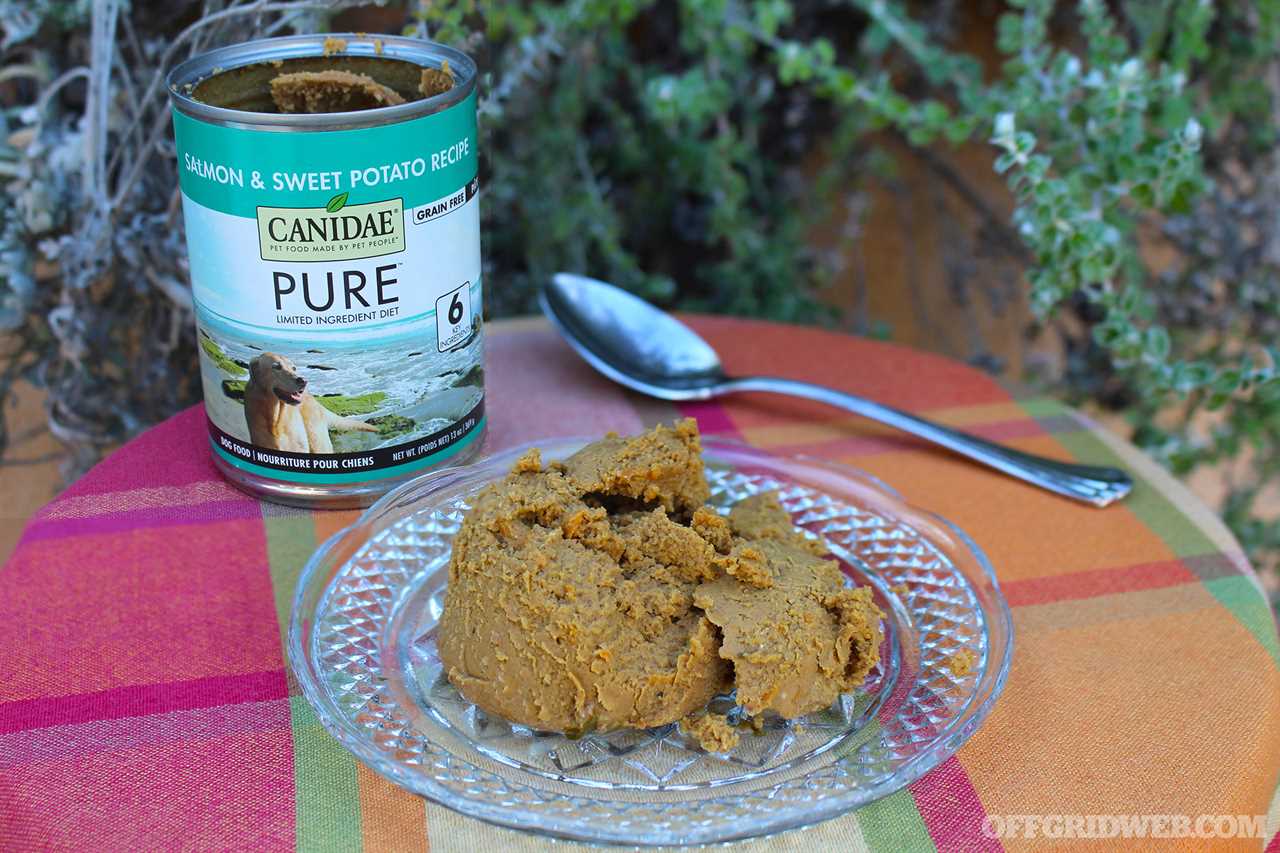
Above: Avoid Canidae’s Salmon & Sweet Potato Recipe if you can. Dogs may love it (ours did), but it lacks a minimum of taste you need to make it palatable.
The results of Felderhoff’s experimental publicity stunt were phenomenal. He lost 30 pounds. His blood sugar and blood pressure went down significantly, and his cholesterol dropped 60 points. “There wasn’t a single thing that was a negative,” Felderhoff added.
Dog Food: A Brief History
Although humans and canines have been faithful companions for over 30,000, the dog food industry is barely 100 years old. Until 1922, with the introduction of canned dog food called Ken-L Ration, very little consideration was extended to the dietary needs of dogs. Draft horses that died in the streets were sliced up and used to feed the local pets, while any leftover table scraps were slopped into a bowl for Fido.
Regardless of the ups and downs of the bourgeoning dog food industry, horse meat was a staple of every brand, so much so, that until 1941 — when horses and tin were being rationed for the war effort, horses were being raised specifically for dog food. The opportunity to create a food without using horse meat led to the introduction of now-popular brands like Purina and General Mills. The first kibble was packaged in cereal boxes in 1956 and by 1964, the Pet Food Institute — the active voice for U.S. pet food makers — convinced millions of Americans that dry kibble was the only option, even though the extrusion process used to make kibble at the time destroyed the nutritional value of the food.
Only when the human health food craze accelerated in the early 2000s, people began to realize that dog food was overly processed and generally unhealthy for their animals. At this time, grain-free and organic kibble became popular, but it wasn’t until the 2016 documentary called “Pet Fooled” appeared on Netflix that the pet food industry’s lack of regulation came to light. It caused a major uproar in the industry and introduced the market to a glut of boutique dog food manufacturers that line the shelves today with the healthiest dog foods the world has yet seen. It is interesting to note that the history of dog food has come full circle, with dogs returning to eating fresh, human-grade food similar to what they ate before the advent of the dog food industry.
What Am I Eating?
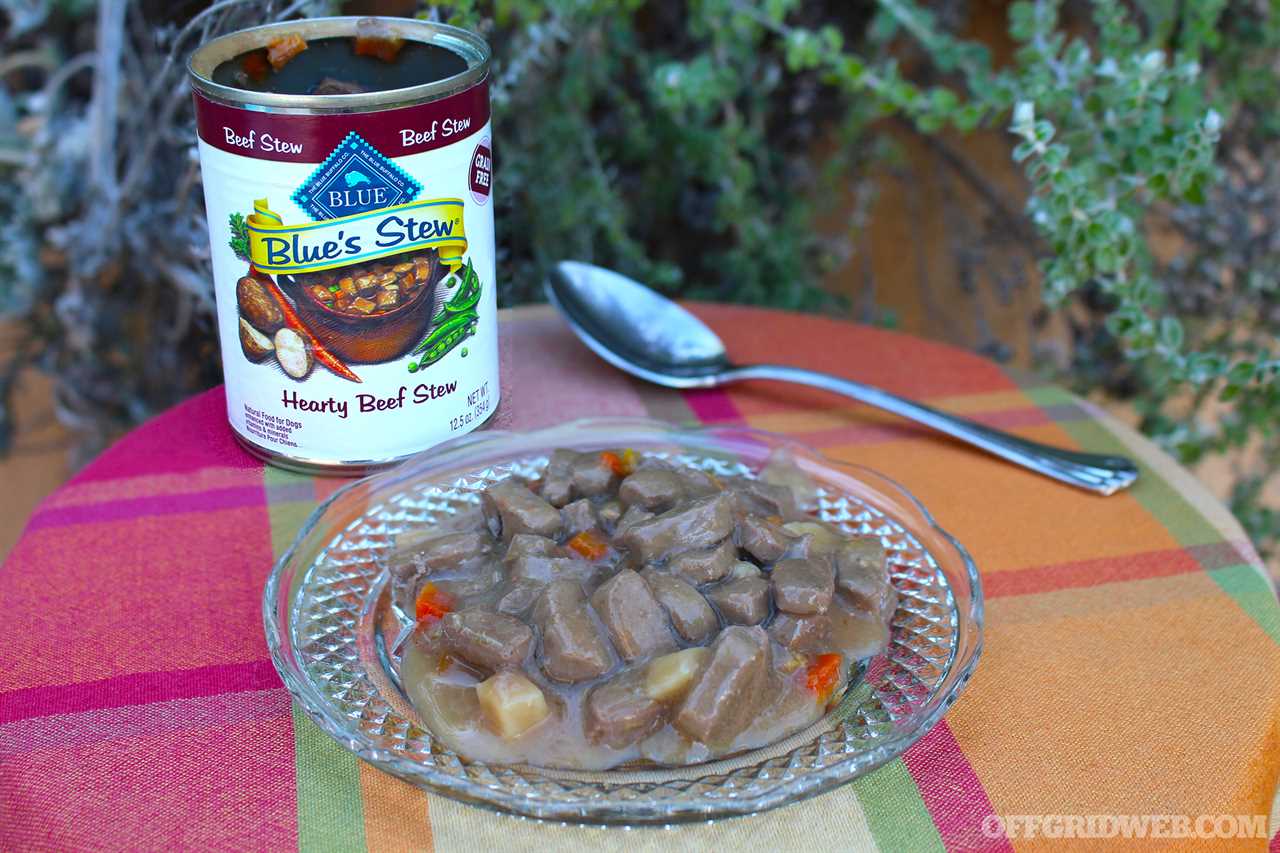
Above: Although the sauce in Blue Buffalo’s Blue’s Stew was flavorless, the taste and texture of the beef resembled actual stew the closest.
Traditionally, dog food is comprised of a slurry of animal byproducts, which are scraps of meat (sometimes from dead or diseased animals), ground bones, various organs, skin, and damaged animal meats that wouldn’t pass inspection if placed in human foods. That’s tradition; however, if you look at the ingredients of any modern can of dog food, you’d be hard pressed to tell the difference between Purina and Campbell’s. For example, the first five ingredients of Campbell’s Chunky Hearty Bean and Ham soup is water, pea beans, carrots, cooked ham, and celery, while the first five ingredients of Merrick’s Cowboy Cookout in Gravy are deboned beef, beef broth, chicken broth, beef liver, and carrots. Campbell’s goes on to list a host of random ingredients used for flavoring, none of which provide much nutritional value; whereas Merrick also includes apples, eggs, green beans, potatoes, and a bevy of vitamin supplements.
Calories: The whole point of eating dog food during a potential starvation scenario is to maintain your calorie intake while providing your body with the materials it needs to stay alive. Dog food keeps a regimented count of its calories in their foods, as the goal of each company is to provide a well-balanced meal for a healthy dog. While calculating a human’s daily caloric need is fairly easy (most adult men need about 2,500 calories to stay active and healthy), calculating a dog’s needs depends on a variety of factors like weight, neutered status, breed, and age.
A single can of dog food, on average, contains about 350 to 450 calories, as it has been determined this is the base needs for most small dogs. A 10-pound dog will need a can a day, while a 100-pound dog will require about five. Given your caloric needs, you’ll burn through a few cans a day if you’re eating modestly, so unless you have several cases of dog food at your disposal, you’ll be trying to survive on a prisoner’s intake. Sure, you’ll be as full as you would if you ate a whole can of soup (the Campbell’s example from above contains 340 calories per can), but the calorie content is still lower than you need.
Protein Needs: Humans are animals, the same as dogs, and we all need protein to survive. Without it, you’ll begin to lose muscle mass, develop anemia (when your cells don’t get enough oxygen), have skin problems, be susceptible to a greater risk of bone fractures, and have an increased exposure to infections. It is the same for dogs, which is why protein content in dog food is so emphasized. An adult human with a low activity level needs about 0.4 gram of protein per pound of body weight each day, while a dog needs about 1 gram per pound.
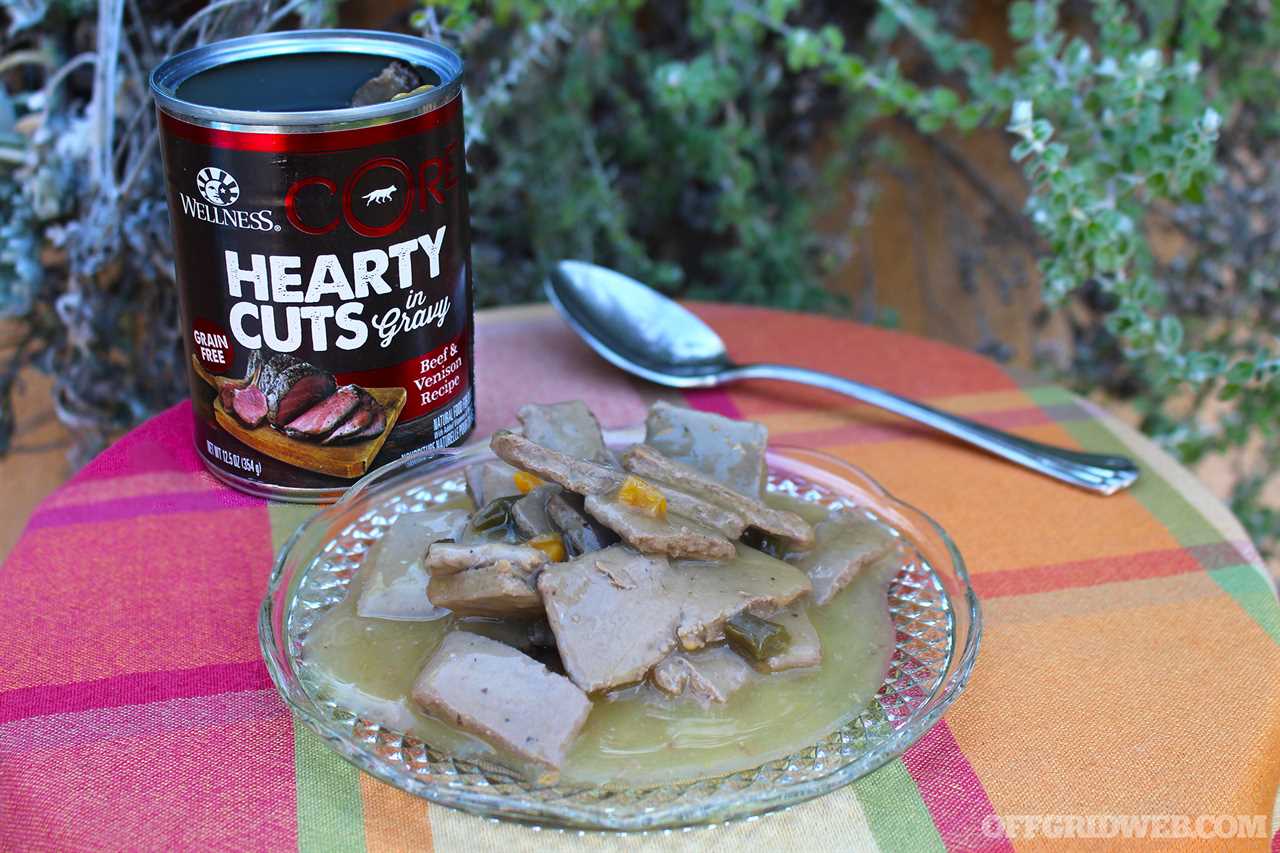
Above: Wellness’s Hearty Cuts in Gravy had one of the most flavorful meats and the picture on the can offered promise (that frankly didn’t deliver). It was meaty but could’ve benefited from more vegetables.
Vitamin Content: Vitamins are very diverse and perform many different functions in a dog’s body (similar to a human’s body), such as the creation of DNA, bone development, blood clotting, normal eye function, and neurologic function. This is why vitamins are packed into modern cans of dog food, especially the more organic varieties. Vitamins A, D, and E are common among the fat-soluble kind, while the family of Vitamin B (thiamin, riboflavin, pyridoxine, niacin, and biotin) are readily available. And if all of those sound familiar, they’re in the foods you eat too and are good for you.
Risks to Avoid
Since dogs have a vastly different digestive system and nutritional needs than humans, their food is tailored to them and not us. This leads to some issues when it comes to cracking open a can of chow for dinner. For example, humans need Vitamin C for healthy skin and a functioning immune system (without it, scurvy sets in), and since humans can’t produce it, we have to obtain it from our food. Dogs can make Vitamin C in their livers, so it is rarely intentionally added to dog food. That said, typical ingredients in most of the dog foods sampled are carrots, green beans, and potatoes, all of which are very high in Vitamin C.
Another health issue found in dog food is Vitamin K3. Known by a lot of names (look for words like dimethylprimidinol, menadione, and/or bisulfate), menadione is toxic to humans in its synthetic form. But only in large quantities, which is rare to find in canned dog food, because dogs can produce the vitamin with bacteria found in their intestines, so it is really not needed. In fact, none of the brands we acquired contained Vitamin K3 or even mentioned the food was a source of Vitamin K.
As with anything, not all dog food is equal, and the cans of food procured for this story were picked at random at a pet store, all around the $3 a can price. That said, these are not the mushy puppy chow you’d find for 60 cents at a discount store, food that’s probably more beaks and bones than real protein and vegetables.
The aforementioned foodborne illnesses can happen with any food product, especially human, so your fears of getting sick eating dog food are valid, as they are with literally any food you consume. If you have concerns that the dog food you’re about to ingest might have been contaminated at the factory, the FDA maintains a list of pet food recall notices at www.fda.gov/animal-veterinary/safety-health/recalls-withdrawals. As of this writing, none of our examples were on the list for 2021-2022.
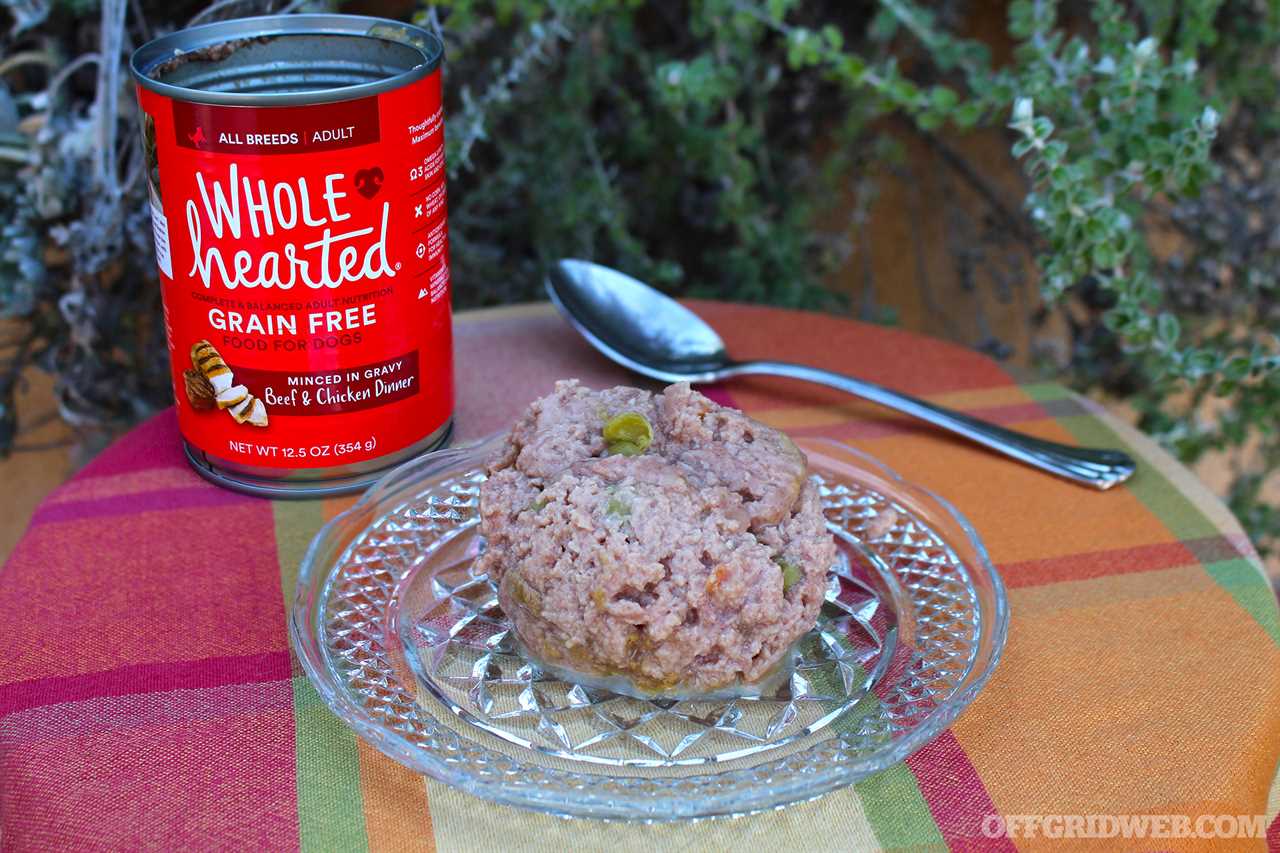
Above: The squishy glop of Whole Hearted’s Beef and Chicken Dinner was difficult to swallow, as its consistency overpowered any appealing flavor. There might be chicken in it.
Reading the Label
For marketing purposes and to fool consumers into thinking they’re getting more than they’re paying for, pet food manufactures use words on the labels that are highly regulated by the Association of American Feed Control Officials (AAFCO). Because many consumers purchase a product based on the presence of a specific ingredient, many product names incorporate the name of an ingredient to highlight its inclusion in the product. There are the 95%, 25%, and 3% (with) and “Flavor” rules.
95% Rule: This applies to products that contain 95 percent or more of the named ingredient. The cans will usually tout this in big letters on the label. “Beef for Dogs” or “Chicken Cat Food.” It’s tricky to discern what percentage of meats are included. The closest in honesty is Acana’s Pork Recipe in Bone Broth with 85 percent “Premium Animal Ingredients,” but those words mean nothing, as “animal ingredients” can mean any and every part of any animal.
25% Rule: Also known as the “dinner” rule, this applies to most of the cans in this story. “Beef Dinner for Dogs,” “Chicken Entrée” or “Salmon Recipe” means that at least 25 percent of the named meats must be in the food. This is shown on the Purina Pro Plan label as it is a “Chicken & Vegetable Entrée.”
3% Rule: Sometimes called the “with” rule, this states that any food label that contains “with” in the description must contain no less than 3 percent of the meat listed. Common examples include “Made with Chicken” and “Dog Food with Beef.” Note Merrick’s Cowboy Cookout: “With Beef…” is right on the label, as it is on Hill’s Science Diet: “Savory Stew With Chicken …”
“Flavor” Rule: If the label has the word “flavor” in the same font size and color as the ingredient name, the manufacturer is not required to put a certain amount of the ingredient in the food. In fact, the ingredient can be any form of the meat listed, which can include the actual meat, any byproduct of the meat, or the broth of the meat. No cans in this story fall under this guideline, thankfully.
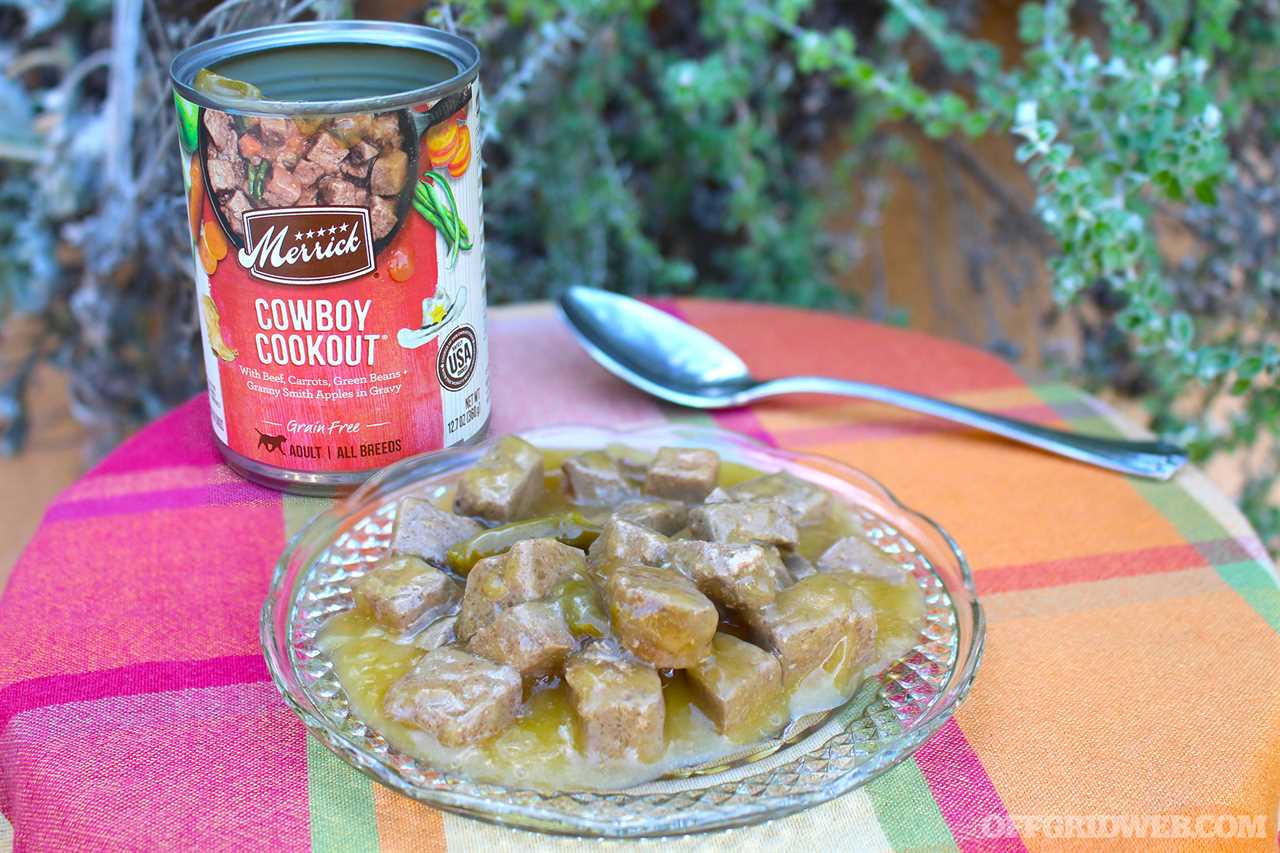
Above: Above: Based on the picture on the can, hopes were high to ride into flavor country with Merrick’s Cowboy Cookout. And although it was a smooth taste with pronounced hints of beef and vegetables, it could stand for some spices.
Taste Test
People throughout history have consumed dog food, whether it was a dare from a cousin, a heartbreaking need from poverty or lack of available food, or as a publicity stunt to sell products. In fact, the term “dogfooding” in business means to use one’s own products, its origins perhaps from a story that the president of Kal Kan Pet Food used to eat a can of the company’s dog food at shareholders’ meetings.
If you’re on the brink of starvation and the pantry is bare, save for a few cans of puppy chow, it’ll be likely you won’t be too picky. Open a can and stave off Old Man Death for another day. However, if given a choice, and to satisfy a sick curiosity, which of the 10 cans of dog food smell and taste the best? We broke down the cans into four groups — beef, chicken, fish, and pork — with most of the examples (five) in the beef category, three in chicken, and one each in fish and pork.
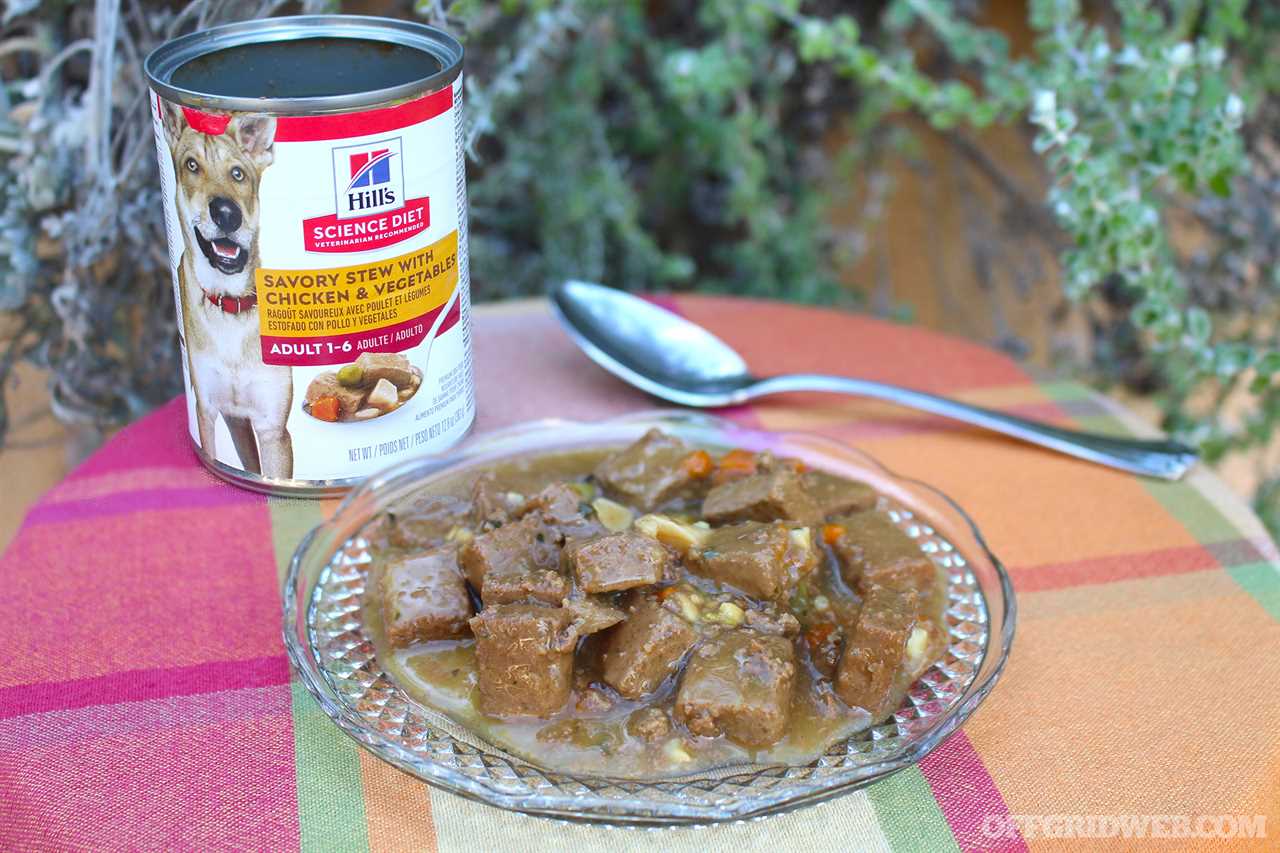
Above: This is the one. Hill’s Science Diet Savory Stew with Chicken & Vegetables is the Author’s Pick for best tasting. Out of the 10 examples tasted, it had the best flavor, reasonable texture, and a consistency similar to an actual beef stew.
Beef: The beef flavors are more appetizing, probably because they look the most like made-for-human stew, featuring strips and chunks of beef mixed with less vegetables than you might expect based on the picture on the cans. The chunks of beef are sizable and easy to eat. The beef by itself is soft, palpable, and require very little chewing as they mush easily in your mouth like wet croutons. The flavors are mild, bordering on bland, but the nose-punching smell more than makes up for the lack of spice. The pâté example — Solid Gold’s Beef Recipe — was particularly difficult to eat, like trying to choke down warm beef-tinted ice cream that just squished between your teeth and matted up on the back of your tongue. It had a semi-sweet dough taste.
The Just Food for Dogs Beef and Russet Potato Recipe wins the award for the most vegetables, but again, the pâté texture of the beef was lathered over everything. Blue Buffalo’s Blue’s Stew resembled actual stew the closest. The beef chunks were a little tougher and the potatoes and carrots were sizable, giving the impression of a normal meal. The sauce was nearly flavorless but hinted of potatoes and butter.
Expectations were high for Merrick’s Cowboy Cookout and Wellness’s Hearty Cuts in Gravy (beef and venison), only because the pictures on the cans looked relatively appetizing (and “Cowboy Cookout” sounds cool!), and although the textures didn’t match any steak we’d ever eaten, at least it offered a mellow, earthy, grassy charm without the stale cardboard aftertaste left by the others like the Just Food for Dogs example.
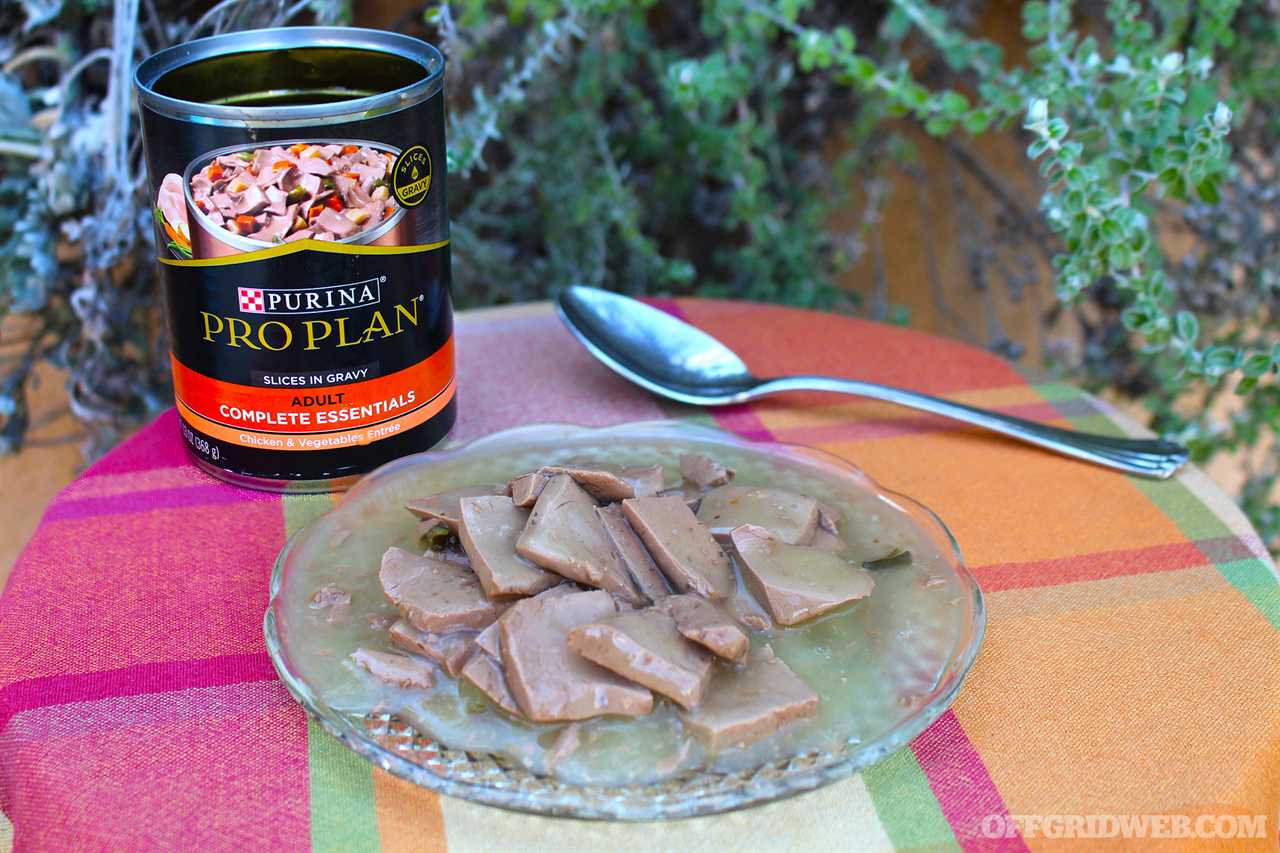
Above: Purina’s Pro Plan Chicken and Vegetable Entrée tastes chalky. The chicken strips were reminiscent of thick noodles drenched in beef broth.
Chicken: The three chicken samples (technically Whole Hearted’s sample was chicken and beef) couldn’t have been any different. For starters, Whole Hearted’s Beef and Chicken Dinner Minced in Gravy was a slushy pâté that coats your mouth like sticky mashed potatoes; it’s creamy and doesn’t require any chewing, which makes it difficult to tell if there’s any chicken and/or beef in it. Its overall taste was similar to mild baby food. Expect little flavor from the chicken examples, especially Purina’s Pro Plan, aside from a slightly sour, nutty experience, like grandma’s chicken casserole where the only flavor she adds is a little salt.
Hill’s Science Diet Savory Stew with Chicken & Vegetables gets the most points for visual appeal. It honestly looks like stew, though the chunks of chicken look like beef but taste like the closest thing to chicken of the three cans. If it was served piping hot from a camp stove on a cold mountain-air night, with the right spices added, you’d be hard-pressed to tell the difference between its raw vegetal beany flavors and regular human stew. Hands down the winner in flavor, texture, and appearance.
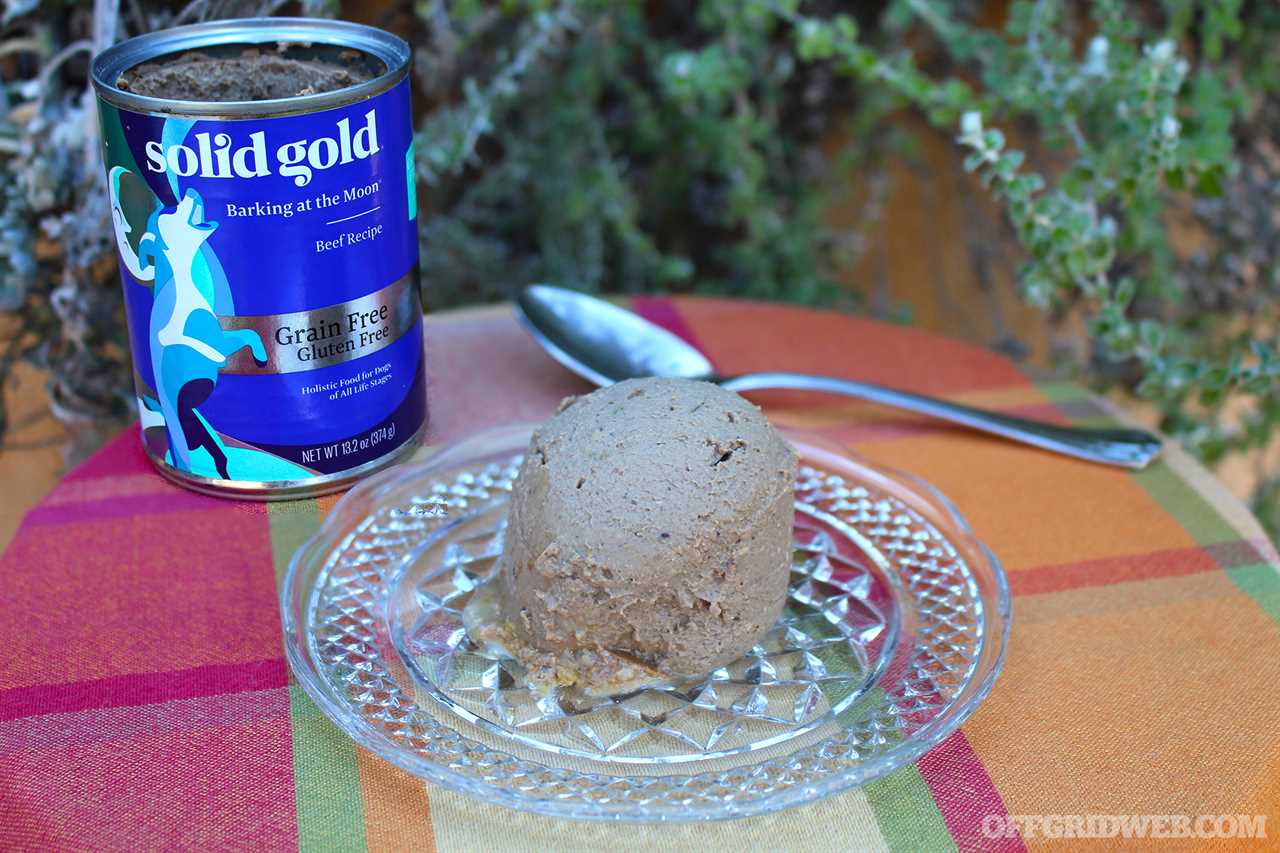
Above: If you like the taste of wet cardboard mushed together by an ice cream scoop, then Solid Gold’s Beef Recipe is for you. It’s shockingly dry for such a wet food.
Salmon: Of the 10 cans of dog food available, the Canidae Salmon & Sweet Potato Recipe is the worst. The creamy texture and mushy stickiness overwhelm any normal tastes you’d expect. You can feel the buttery oiliness wash over your mouth, and it smells like salmon more than it tastes like salmon. It fills the mouth with a bready and doughy flavor like thick unbaked cake. Even if you’re starving, eat this one last.
Pork: There was only one can of pork dog food available at the pet store we visited so there was nothing really to compare it to except for, you know, pork chops on the grill. Surprisingly, Acana’s Pork Recipe in Bone Broth was closer than we thought. The strips, though easily broke down under the slightest teeth pressure, were a little rubbery with a mild aftertaste like bland baked beans and flour. The hints of carrots and pieces of cranberries, pumpkin, and blueberries provides a sweetness we weren’t expecting, giving the whole flavor spectrum a surprisingly pleasing quality (relatively speaking). With some added spices and maybe a few more potatoes, this would make a fine stew.
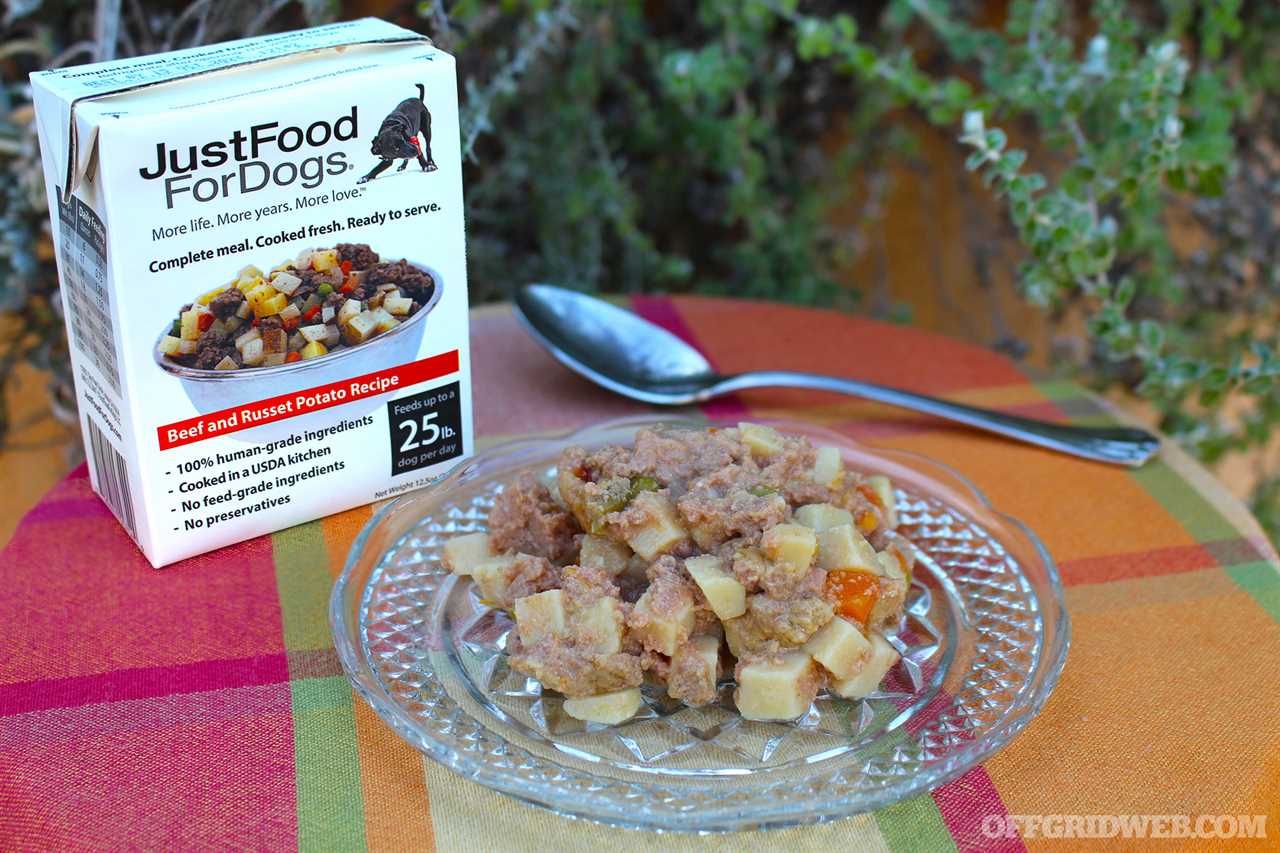
Above: Just Food for Dogs’ Beef and Russet Potato Recipe had the most vegetables in it but its overall flavor was underwhelming, similar to an overly wet casserole. It tastes like quiche, made by someone who doesn’t know how to make quiche.
Quiz: Which Would You Eat?
In each of these two pictures, there’s a plate of dog food and a plate of people food. Without trying to guess which is which, of the four plates of food, ask yourself which looks more appetizing. Do the chunks of beef drizzled in a lather of gravy and speckled with carrots and potatoes look better than the plate of beans with ham chunks, carrots, and slices of celery? What about the lentils served in an olive oil sauce of organic potatoes and onions?
If you were presented these four plates at a dinner party, which would you take? A? B? C? D? Answers appear immediately below this photo.
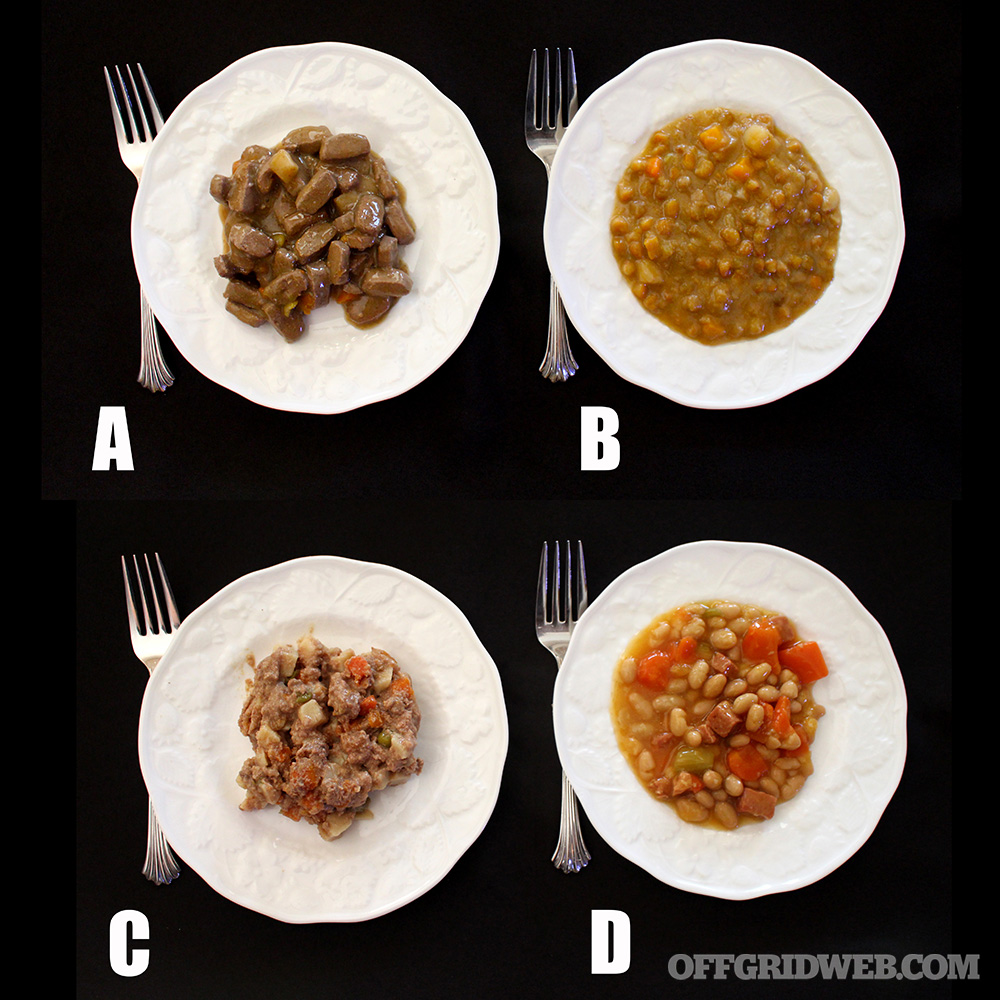
Answers: A. Dog food. Blue Buffalo Blue’s Stew; B. People food. Amy’s Organic Lentil Soup; C. Dog food. Just Food For Dogs’ Beef and Russet Potato Recipe; D. People food. Campbell’s Chunky Hearty Bean and Ham Soup
Conclusion

Having brushed our teeth and rinsed with some mouthwash, we were reminded that dogs have been eating people food for thousands of years and thriving. In just over 150 years, dogs went from table scraps and leftovers to harmful kibble to top-notch wet canned food that uses human-grade meat (nearly in some cases), USDA-approved production methods, and the highest level of safety standards set forth by the AAFCO. Dog food has come a long way, and as quality increases, advancement in food technology develops, soon a can of dog food might be indiscernible from a can of human stew.
Overall, if you were in a situation where the grocery stores have been picked clean, head on over to the dog food aisle (better yet, hit the pet store as it will likely be overlooked by the hordes of hysterical panic shoppers) and look for the expensive cans of dog food that are produced by niche companies that tout real meat and high-quality vegetables. You’ll likely have a pretty good meal, something survival snobs might have passed over (and starved to death).
Related Posts
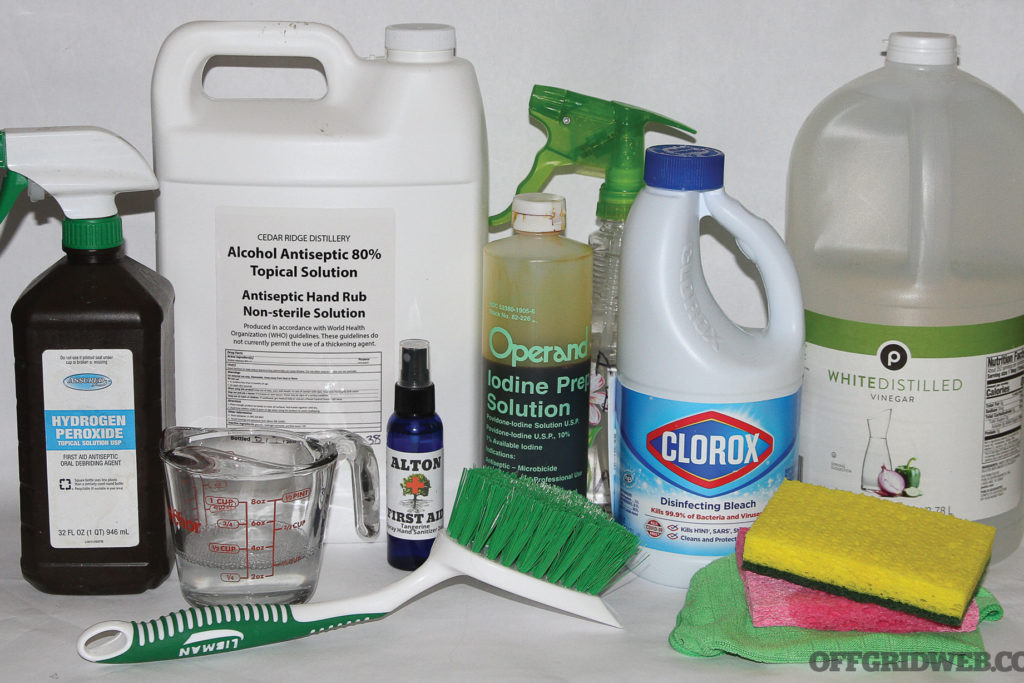
DIY Disinfectants: How to Fight Diseases with Limited ResourcesStrict attention to hygiene and use of disinfectants, both off-the-shelf and improvised, will save many lives in the aftermath of a disaster.

Outlast on Netflix: New TV Show Blends “Alone” with “Lord of the Flies”A new Netflix series called Outlast splits 16 contestants into teams to see who can survive longest and claim a million-dollar cash prize.

Secure Messaging Apps: Signal, Keybase, Threema, & MoreThere are many secure messaging apps out there, but many are beholden to big-tech oligarchs who don’t value your individual freedoms.

Bag Drop: Red Oxx Search and Rescue Duffel BagThe Red Oxx Manufacturing Sherpa Jr. serves as a “mothership” to my smaller search and rescue bags and keeps my bulky gear all in one place.

First Aid in the Field: Become Your Own First ResponderProlonged Field Care focuses on what first responders can do after stabilizing a life-threatening injury and evacuation to higher care.

Encrypted Radios: Off Grid Comms Offers AES-256 Encryption for CiviliansOff Grid Comms offers ready-to-use encrypted radios for civilians. They're based on the P25 digital standard with AES-256 encryption.

Burner Phone Basics: How to Set Up an Anonymous Prepaid PhoneToday, threats to privacy abound. Those of us who require anonymity can still get it through the use of a prepaid, disposable burner phone.

Pocket Preps: IFAKs for Everyday CarryThe IFAK (Individual First-Aid Kit) has been a standard military item for generations and has become common with other first responders.

A Quick Look at Smartphone Security AppsWe looked at a few smartphone security applications that can help you protect yourself, your data, and your hard-earned currency.
The post Canine Cuisine: Eating Dog Food in Dire Situations appeared first on RECOIL OFFGRID.
By: Offgrid Staff
Title: Canine Cuisine: Eating Dog Food in Dire Situations
Sourced From: www.offgridweb.com/survival/canine-cuisine-eating-dog-food-in-dire-situations/
Published Date: Sun, 19 Mar 2023 11:00:18 +0000
-------------------------------------------------------------------------
Did you miss our previous article...
https://outdoorsnewswire.com/survivalist/how-to-identify-chemical-attacks-by-symptom
 CampingSurvivalistHuntingFishingExploringHikingPrivacy PolicyTerms And Conditions
CampingSurvivalistHuntingFishingExploringHikingPrivacy PolicyTerms And Conditions
